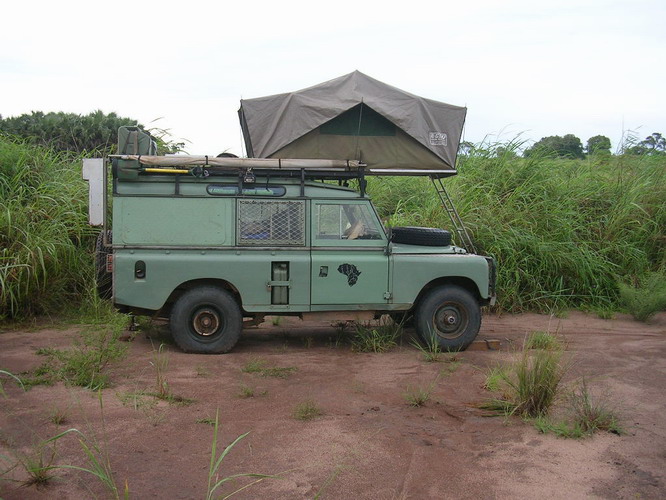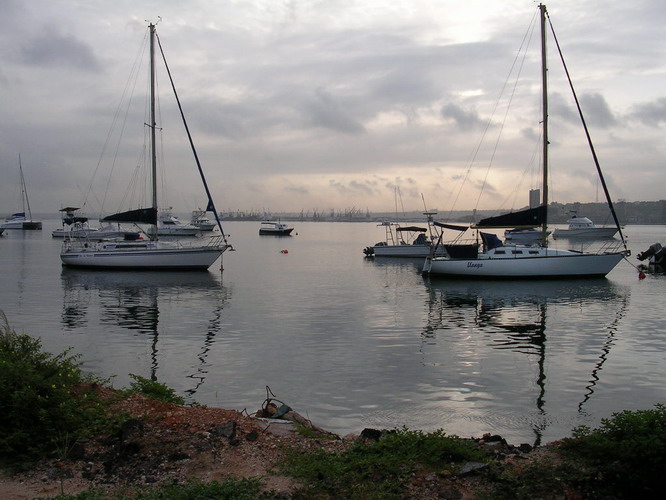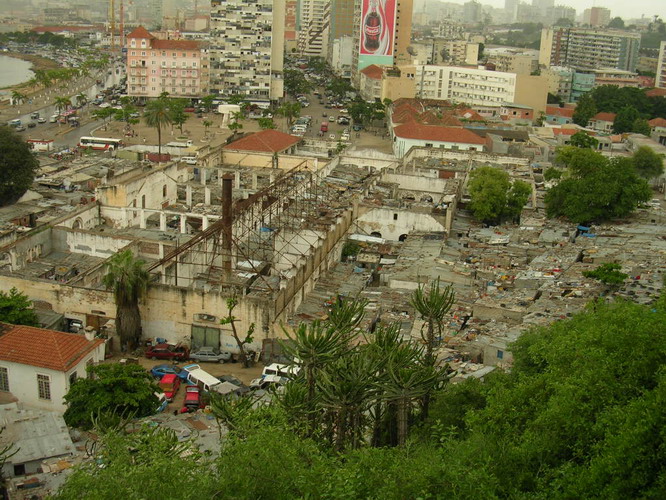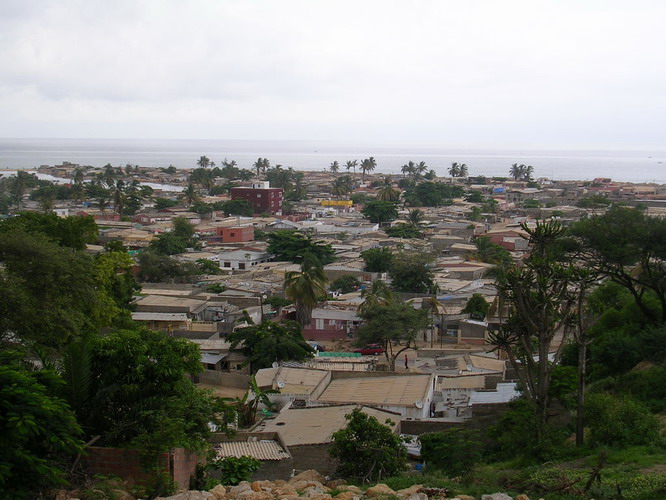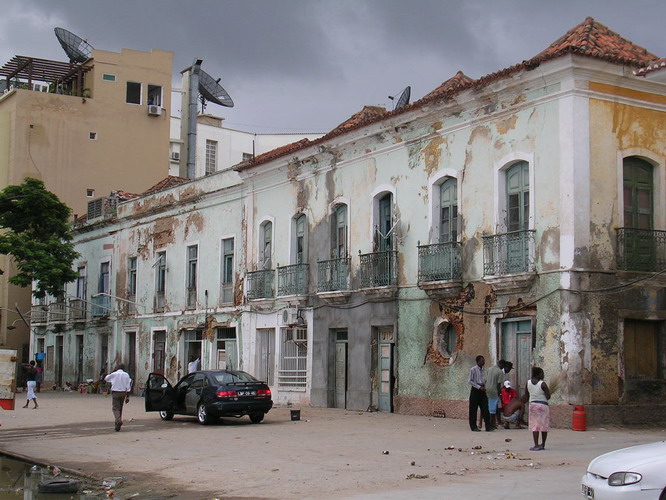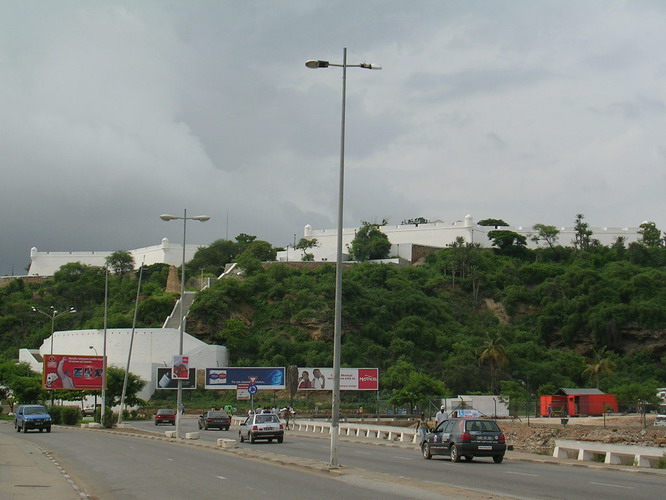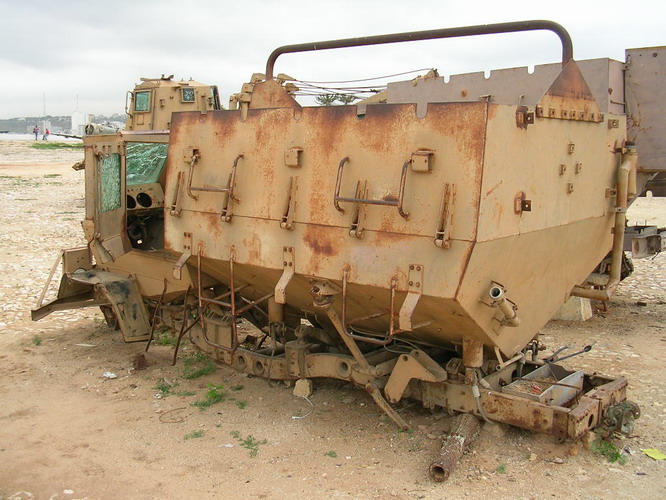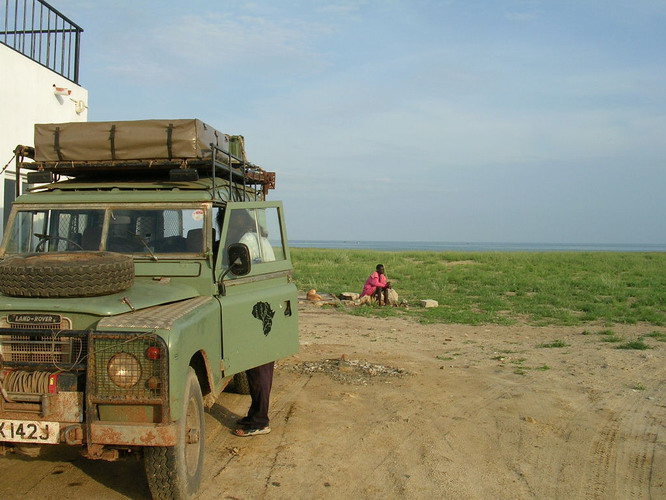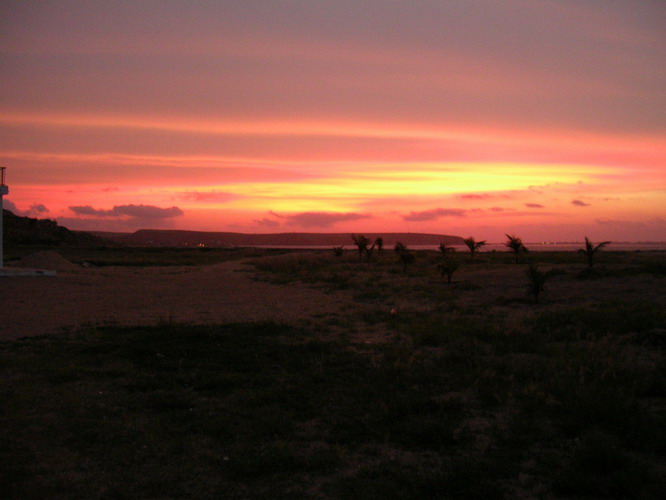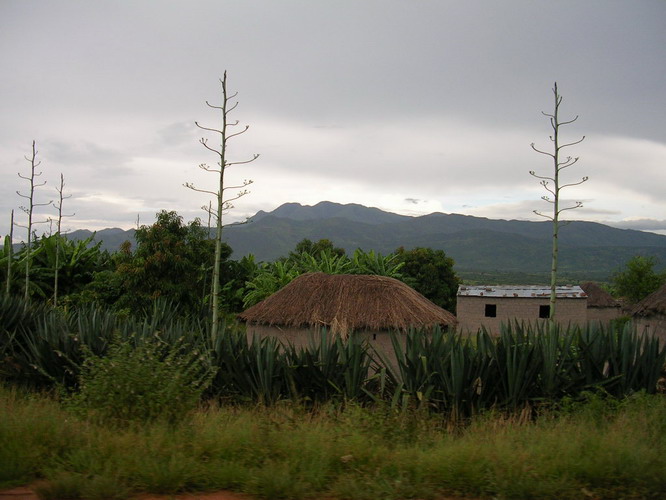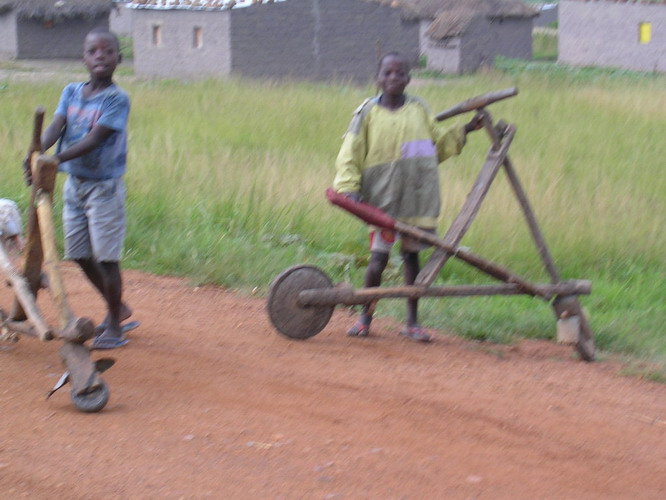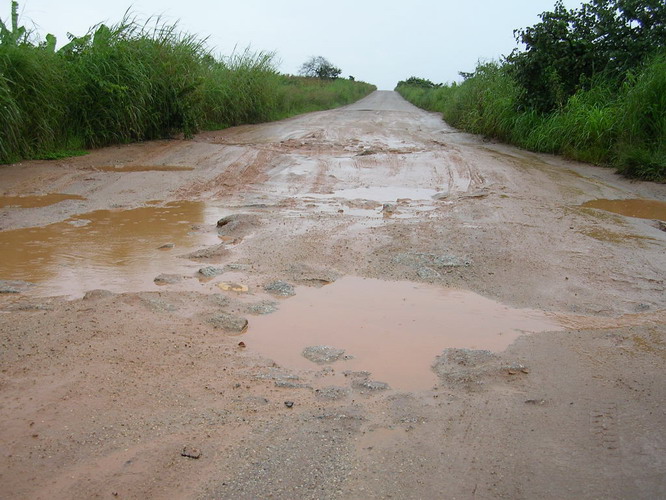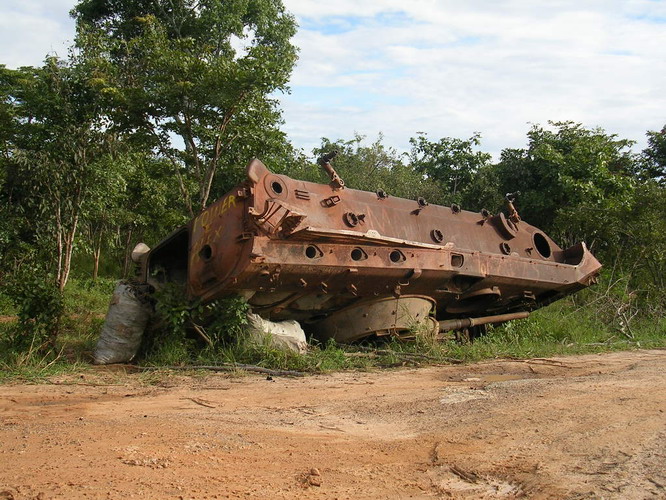Day 150: Thursday 10 February
Here is a picture of our route from DRC / Matadi, across the border at Noqui and then via Mepala, Tomboko and N'Zeto to Luanda. It was a rough one!
The first person we met on the Angola side was a policeman who demanded US$20 to open the boom, being kind enough to accept the equivalent in any currencey. Aye, right. We parked the car and went into the office, armed with carnet, passports and Portugese phrasebook. Luckily the official spoke French as well, which made things that much easier for us. That part of the process was fairly quick, meaning that the whole crossing took a mere hour and a half. Next to find the road through Noqui and down towards Tomboco, past an expensive looking pink hotel and a tired looking run-down one, evidence perhaps of former wealth in these parts.
Suspension Realignment 101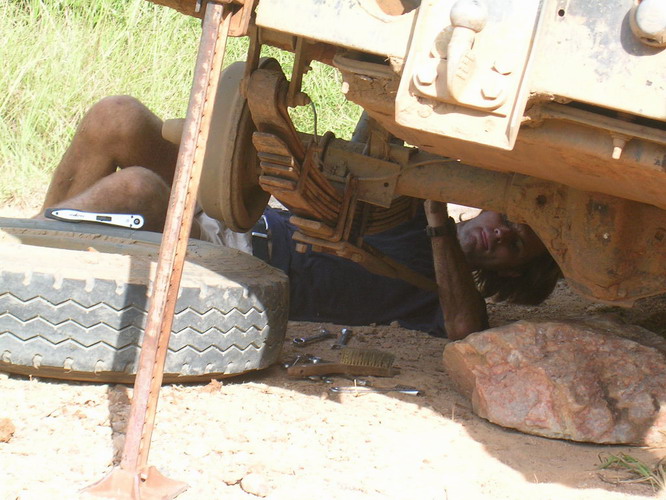 |
MPLA village |
Green from the rains |
The road to Noqui was tarmac; after that the fun began: hilly rock-hopping and rough, narrow piste, very uneven and potholed, which was to take us 13 hours over 3 days due to the mud and rocks, which alternated and vied with one another to provide the most difficult stretch of the day. It did, however, provide fantastic scenery and went through several villages each of which was flying the flag not of Angola, but of the ruling MPLA party.
On the way we picked up a hitch-hiking soldier, but then started hearing funny noises from the suspension and stopped, apologised and explained as best we could that we would not be going any further. It turned out that due to the roads to Boma in DRC and now the rock-hopping in Angola, the rear far side suspension leaves had begun to slip, causing that wheel to lie far too far back. This meant jacking her up and hammering the leaves back into place, then using a scissor jack between axle and, unfortunately, fuel tank to push the axle back into position. The process took us a couple of hours but was successful in the end, although we sensed that it would have to be repeated once or twice more along the way.
In due course we were off, finding a great level spot to bush camp (S5º59.630 E13º32.959), making a cup of tea and pitching the tent as the sun set. We were then treated to a most spectacular fireworks display from the heavens, which were lit up from behind hugh white cummulus cloud, with lightening flashes accompanied by thunder crashing. Only high quality video could have captured this, but still we tried to get some record of it on the SLR camera. Other accompaniments were villagers passing by greeting us and even trying to sell us fresh whole antelope, which we politely declined in favour of now day old pasta salad. You really One does have to question the wisdom of this, but let's leave it at that for now.
Day 151: Friday 11 February
A hard day, driving all day wondering about the choice of vehicle without power steering, on roads that take you where they want you to go. Bad piste. Plenty of mud as well as rock-hopping. Had to use mud-mats and branches on a couple of occasions, but managed to get out of trouble each time without recourse to anyone else's vehicle - not that any other vehicles were about, but there it is. As we drove on, the terrain became less dry and more jungly. It became difficult to pass anyone, which involved one hairy moment with a, rare, large lorry coming hurtling towards us requiring us to reverse speedily into the bush. This was done to our safety, but at the expense of a rear window pane through which a tree found its way in the process.
As the dusk approached, it was time to find a place to camp. Then came the most scary moment of the trip so far. Down a fairly steep slope on a muddy clay surface, we slid, ending up at an angle close to tipping over to the left, with 3 out of 4 wheels grounded but slipping, and with light fading fast. First to take stock. How to get out of this one, landy at precarious angle, fuel pump still going strong and needing to be switched off. That involved opening the bonnet because a former bush repair had involved connecting the fuel pump directly to the battery, via a fuse but not a switch. Bad idea. The bonnet started to come off and is very heavy with the spare wheel on it. Still, we managed to put the pump off and replace the bonnet, then take stock of the situation again. We tried to use the Hi-Lift to jack up back left in order to ground back right wheel, but that just lifted the whole thing higher still. Eventually we decided to jack up front left and place a mud mat under back right, which was now finally grounded. Then rev high and release clutch fast, and reverse off the jack. That worked, but left us both shaking.
Suspension Realignment 102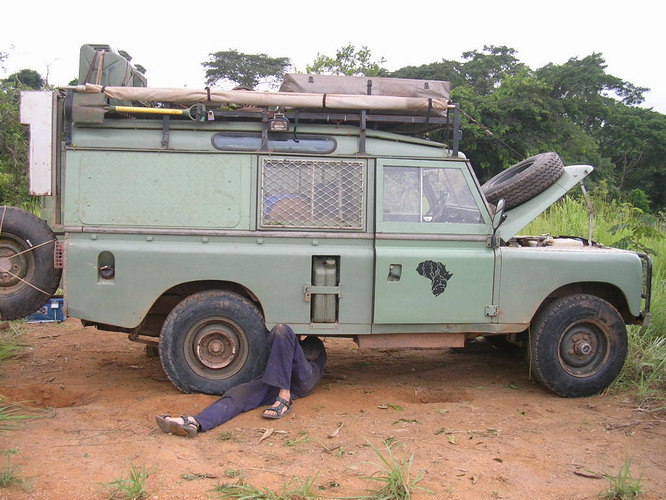 |
Next to find a place to sleep, which proved very difficult because of the narrow road and lack of place to pull off, let alone a level place to pull off. It also involved driving through the jungle in the dark, but we had no choice as pitching the tent in the road was a non-option. In the end we did find a plce, at a junction that seemed now-disused: S6º42.255 E13º22.566. If ever there was a time for a whisky and a cigarette, this was it. We had water though, and now 2-day-old pasta salad. A poor substitute, but so it goes.
Day 152: Saturday 12 February
Breakfast bars and water for breakfast - this is just getting silly now! Then Murray did the third suspension check and realignment while Moira assisted and tried to capture on film the wild monkeys in the area. Soon after that we headed south, keen to finish with this road and get to a safer one.
After the junction at Tomboco, the piste was still bad, but was at least a slightly flatter road. Soon the piste changed to potholed tarmac, one of our least favourite surfaces. From Tomboco we headed towards N'Zeto, where we drove around the sleepy, almost ghost, town in search not so much of fuel (which would have been useful if not entirely necessary) but for air for one of the tyres which had a slow leak: to no avail on both counts. So we drove on and found a lunch spot on a stretch of road that is being rebuilt / resurfaced.
Definitely the rainy season |
It was there that we changed the flattening tyre and also noticed that the front nearside hub was loose. Murray checked to what extent this was the case and concluded that it would be safe to drive on, but slowly. At this point we also changed the fridge fuse, because let's face it, having cold water after a hot stretch of driving is without parallel. After lunch we drove on, but on first using the brakes, they failed. Luckily we were going slowly and there were piles of road- building sand to cushion our halt. On inspection it was clear that some of the seals to the wheel cylinders had gone, as brake fluid was emptying itself from said wheel. Fortunately we had in our bag-'o-bolts one of just the right thread to plug up that brake line. So there was another reason to drive slowly: braking on only three wheels causes, in this case, 3 tonnes of meccano set to pull hard to the left. But press on we must.
Fortunately it was only 25km to a place we knew from previous Overlanders (thanks KSV2) we would be able to bushcamp: S7º37.939 E13º04.797 which was in a sand quarry. We were able to have supper outside, but soon after going to bed, another wild storm descended once again to test the water- and wind-proof qualities of our tent. It passed and we stayed dry!
Day 153: Sunday 13 February
The ground was by now sodden but at least it had stopped raining. And anyway, we'd been through a lot worse (see above!). And so having checked the suspension etc., we hobbled on at 20km/h, not so much because of the mechanical issues, but because the relatively heavy rain had made the piste very muddy indeed. This was made all the more difficult because we didn't want to use 4x4 at all, due to a loose / damaged front hub. So quite a lot of slipping and sliding of our rear was the order of the day.
On the way we passed bridges that had been so eroded by the rains that it made them feel pretty hairy to cross. At one such bridge the road was so narrow that it had caused a lorry to tip over and down the steep, now muddy, embankment. We made it across OK, but only because we are relatively narrow. It was nerve wracking though. We were to see several overturned lorries along this stretch of road, at least one of which looked as if it had happened only last night or even this morning and a crowd had gathered. The road improved gradually as we moved out of the area where the rains had been heaviest last night. This is not to say that we were now on pristine tarmac. Far from it. Just a track with better grip to it! There was tarmac though, but it had been disintegrating for years and had in parts been covered with the sand that is supposed to be underneath it, now having come out of the potholes that had developed.
Outside of Caxito we went through a police check which was very quick compared to reports that we had read involving vehicle searches. After Caxito the road improves dramatically, providing smooth tarmac with the occasional pothole the rest of the remaining 61km into Luanda. Even so, we were reluctant to go any faster than 40km/h due to the various mechanical problems we had acquired on the hard roads through DRC and northern Angola.
As we drove into Luanda - about 20km from the centre - we started to see signs of serious wealth: many new 4x4s, folk out for the day spending money (well it was Sunday!) and big houses. We also saw a Land Rover dealership and entered it as a waypoint (S8º46.981 E13º18.754) making a mental note to come out here tomorrow and investigate getting Puff sorted out.
Luanda is a sprawl, involving shanty town areas close to the CBD and upmarket housing and apartments. Like many African capitals, it is a land of contrasts. We drove through the hectic, rubbish-filled market towards the Yacht Club, where once again we had heard that we could camp. The Club Naval de Luanda (S8º47.924 E13º13.458) is on the upmarket and well developed waterfront, which has several bars and restaurants. We arrived looking and feeling very much out of place, dirty and disheveld after days of mud, grime and fatigue and went directly to the yacht club bar for a beer or three. The waiter was a very pleasant first-Luandan to meet, and he spoke English too. The beer in question was Cuca, which is sold in 31cl cans and bottles and is available on tap at certain establishments. It contains a mild 4.5% alcohol and is a middle-of-the-road lager that is light and refreshing, although among the more gassy beers. It was such a relief to have made it to Luanda, we certainly enjoyed those beers!
Camping at the Club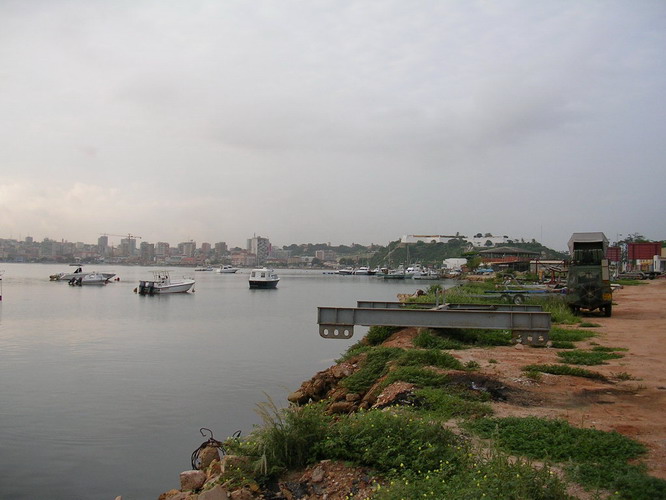 |
Towards evening we were able to speak to the patron or his representative and confirm that we could camp there and indeed have a shower. Bliss! We were also able to do some long-overdue laundry. In the evening we went to the yacht club restaurant for some small cooked items, tapas style, from the very expensive menu, but to be honest we hadn't the energy to look any further. We were in bed by 9:30pm, trying to get some sleep despite the noise of local clubs and bars here on the peninsular - such a contrast to the quiet of the countryside, apart from insects and thunderstorms, that is.
Day 154: Monday 14 February
Luanda through the rain |
Murray up early to get some bread for breakfast (Portuguese Rolls ) and back to find Moira, make breakfast and sit at the now-deserted yacht club restaurant/bar/jetty to write our diary and watch the fish jumping in the bay.
It was then back across the city to the Landy dealer where we were lucky enough to find an english speaker, Nono. There followed much discussion, much looking at Puff and the calling in of the manager. The manager, in an admirably upfront manner, told us that we would be better served by going intsead to the mechanics across the road, explaining that they would be more ingeneous and less expensive. So with the help of Nono we negociated to come back the next morning for the work to be done by them.
So with the arrangements for the Landy to be fixed set up, it was time to be in touch with folk via a cybercafe in the centre of town. After which we treated ourselves to a great lunch of pizza and beer. A feast! And at a price too, pizza for two setting one bach US$20.
In the evening we went to a local, upmarket, bar. The system at the bar was that you paid for a card in dollars and this card gave you credit for so many drinks. $15 worth was soon consumed! Whilst busy consuming we met some expats, including a chap called Rob who is the Angolian manager for British Airways. The bar was also a restaurant so as we were feeling a little peckish, we ordered some Portuguese-style sea-food croquettes. Some folk in the resuarant were obviously out for a Valentine's Day meal, otherwise the day of pink hearts and red roses had entirely passed us by! Which was nice.
Day 155: Tuesday 15 February
Up and headed for the mechanics. It was to prove a fairly long though not unenjoyable day, watching the mechanics whilst they worked by the side of the road. It was also interesting watching the numerous passers by going about their business. Many of whom were mobile street traders and we could have a good look at what they were selling as they went passed. We variously bought: toothpaste, a torch, soap, bread, and fruit. We even bought food from a woman carrying several trays of eggs on her head. It was obviously a common way to get a snack and the (boiled) eggs came with a tasty though seriously spicey sauce.
It was a rare treat for us to find mechanics who new their stuff and just quietly got on with it. The boss (who was clearly of Cuban origin) was careful to check their work and would tell them to re-do things if he was not entirely satisfied. Oh joy! We were even offered beers by the boss and tried two local brews, Nocal and N'gola. Nocal is a beer with serious body and is quite filling as a result, rich in flavour and relatively malty though not too gassy at 5% alcohol. The main problem is that even although it is brewed in Luanda, it is rare in the bars we went to. N'Gola contains the same alcolol and full-bodied malty taste, but is far more gassy and has a slightly bitter aftertaste - though in the real ale sense, so no bad thing. Being quite a heavy beer, it is not for drinking all evening. We were to see more and more of it as we got towards Lobito, as it is brewed there.
The mechanical work was completed by about 4:30 pm and $300 was handed over without the usual arguments over the bill and sudden hidden costs being added.Then it was back to the Yacht Club to celebrate Puff being in one piece again.
Yacht club from fort |
Day 156: Wednesday 16 February
After packing up the day started with a visit to Luanda's fort, Fortaleza de Sao Miguel, which marks the skyline of the bay. It was originally built by the Portugese and brought back memories of Lisbon for us with its blue and white interior wall tiles and the white and black patterned paving. The fort is now being used as a military museum, illustrating various periods in Angola's history including its fight for independence. The civil war was not described in the museum, however, around the fort were sitting various pieces of bullet ridden armoured vehicles, emotive symbols of the recent past, the South African Infantry vehicles serving as victory trophies outside the museum, arguably a wee bit distasteful as it is unlikely any of the former occupants would have survived. But judge for yourself.
Back at the Yacht Club we savoured a couple of espressos each, made with a Portuguese brand of coffee, Delta. This was a real treat as we had not had a properly hot drink since the gas had run out in Matadi. Over coffees we made a final decision about our route and decided to take the coastal route south, via Porto Amboim and Sumbe to Lobitothe ground that the war had been for the most part inland and the roads had not yet been repaired., on. So it was time to get back on the road again, though not without some trepidation as to what would face us.
Before leaving Luanda we popped into Rob's British Airways office for a chat. He kindly offered us some magazines and not-too-old newspapers. He directed us to the western-style supermarket (we have found one in every capital we have been to) so we could stock up on supplies before leaving town. Handily, there is a Bureau de Change inside the supermarket which allowed us to change US$ into Kwanzas. After munching our lunch in the supermarket car park we headed out of Luanda.
The road along the coast started off well and was reasonably tarmaced until after Kwanza bridge (S 09º19.491 E 13º09.959), passing what looked like a mixture of locals houses/shacks and wealthy Luandan's country houses. After the bridge (no toll) the road very gradually detioriates. The countryside was surprisingly green, us finding it at the end of the rainy season, and the area through the Parque Nacional da Quicama consisted of rolling hills and fairly dense vegetation supporting lots of bird life.
We turned off the road at dusk to find a place to camp (S9º 56.590 E13º 23.434). Our usual trick is to wait until sunset/dusk when the light is fading and search for a moment when our stretch of road is clear of both cars and people. Then we try to quickly and quietly turn off the road and drive into the bush far enough to find a spot out of sight and hopefully out of ear shot of passers by. This does not always work and sometimes we are spotted. If it is local villagers who have spotted us we tend to go and introduce ourselves and ask permission to stay in their area. Usually, we have been met with curious but friendly responses such as, 'but why don't you come and sleep in the village?!'
Day 157: Thursday 17 February
Today was our usual on-the-road routine of up, store away the tent, pack up generally, make breakfast and head off for a day of driving. The road continued to be tarmac but with the condition gradually detiorating and the frequency of potholes increasing. Fortunately, there were markets in the bigger villages/towns were we could stop and buy food. We had heard that bread was difficult to find in rural Angola but, after a little searching, we managed to find it in the markets without any problem, at 10 Kwanzas per Portugese style roll and very nice too.
Arriving in Lobito we found a petrol station that did in fact sell petrol (diesel generally being more available). There are a lot of new petrol stations being built in Angola so we imagine this problem will not last much longer. On route we noticed a creative interim solution to the fuel shortages in several towns where we came across a fuel pump unit that was housed in a solution to their lack of fuel (stations).
At a proper fuel station in Lobito we met two bikers, a german couple who are also driving down the west coast of Africa. Unfortunately, we could not chat for long being late afternoon. After fuelling up and buying 4 litres of oleo for Puff's engine we headed through Lobito towards Benguela, on good tarred, though busy, road. In Benguela we stopped at a bakery and bought still warm loaves of bread using lots of gestures and our few words of Portugese. We are glad that we brought a Portuguese phrase book with us despite it not having the word for bread in it!
Wet & green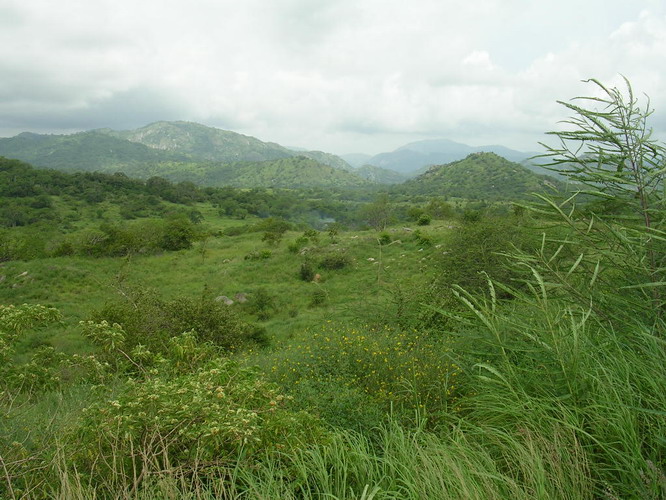 |
Unfortunately, after stopping for bread Puff did not want to re-start, a case of being too hot? But after a push from some locals we got her going again and headed for the beach near Baia Farta to
camp for the night, thanks to a waypoint from KSV2. and care of Julian in Pointe Noire (S12º36.547 E13º15.506).
The beach was not quite the idyllic spot we had hoped for but it was quiet and we witnessed a glorious sunset. We had parked next to a new building that probably wasn't there when KSV2 came this way, the night guardian of which soon found us and wanted to chat despite the communication difficulties. He kindly showed were the well was and was satisfied with the 40K we gave him for a packet of fags. For supper, we had another go with the Primus stove but the best it could manage was lukewarm cup-a-soup!
Day 158: Friday 18 February
After a rare peaceful night and therefore a good sleep, we packed up and headed back for Lobito, having decided to take the main (in land) road south rather than sticking to the coastal roads as we were concerned as to whether Puff's suspension could handle the coastal route which we had heard involved a lot of rock-hopping.
It was with some concern however as the term 'main road' does not necessarily mean good road here in Angola! This concern was soon to be justified as about 30 kms out of Lobito (i.e. soon after the Sumbe road junction) the road disintegrated. The driving was not made any easier by the steep mountainous route and the heavy rains which turned the road into a stream in many places. The road climbs for many kilometres and what with the thunderstorm it was certainly dramatic with wild skies, towering moutains and a deluge descending on us. Eventually, the storm passed and the road flattened out onto a high plateau (approx. 1,500m to 1,800m) making the driving still difficult but less hairy.
Again we drove for the whole day until it was time to find a camping spot. We decided it was too late in the day to get to a rural spot, so asked at a settlement if it would be OK tocamp at what looked like a derilict building. The woman we spoke to said she would call the man of the house, who came out with another man. He said that they were priests and that the derelict-looking building was in fact their church. He also said we could camp in their compound. Fantastic. We drove in and talked for a while (he had some English) and then left us to our own devices. We gave them a couple of beers we had in the fridge by way of thanks, had a sandwhich for our supper and went to bed. It's great, every now and then, to find a place that is safe, with people who are friendly and where one can get water from a well.
Day 159: Saturday 19 February
In the morning we packed up to head off, but not before chatting for a chile and exchanging contact details. They then brought us a chicken, insisting that this should be our breakfast. We said that we had no way of cooking it, but the cat was out of the bag about not really wanting to slaughter and pluck it when Murray ended up stroking her as she lay in the woman's hands.
Bad mountain road |
Our priestly friends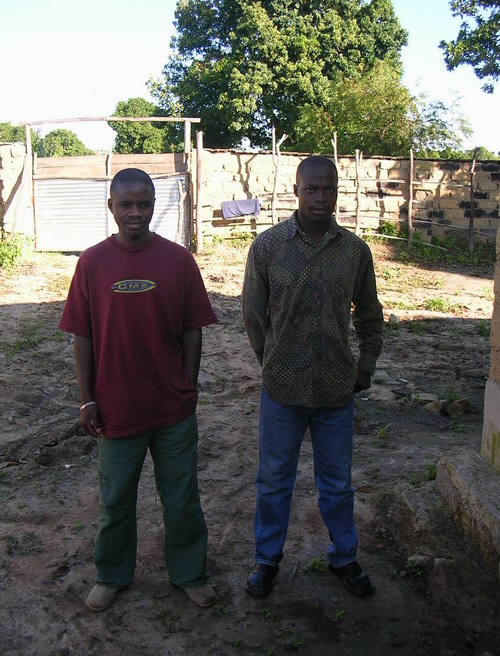 |
The route we were driving took us from Lobito up into the mountains and onto high plateau through Balombo, Wama, Huambo to Caala. After Caala the road briefly improved and for about 50kms the potholes were slightly less severe! Due to the atrocious nature of the roads many people chose to drive alongside the roads and tracks form running roughly parallel to the main road. At times these can be a good alternative to the suspension/kidney hammering tarmac, though at other times the tracks/ piste can be just as treacherous especially in the rainy season when they are filled with giant puddles and deep muddy sections. This was particularly true when we were in the (planted) forrest areas were the road became a 'mudfest'.
At the end of another long tiring day we camped at S13º 26.126 E15º 22.811. These roads were certainly taking the toll on all three of us but, for the 2 humans at least, the scenery was an excellent consellation! With dramatic granite outcrops, fresh green grasses, cosmos daisies and colourful butterflies being a feast for our eyes.
Day 160: Sunday 20 February
The morning was cold for us due to the altitude (1,633m), being about 14.5 degrees at 8:10 am. This meant that the inside of the tent had to be dried due to the heavy condensation. The road kept up with expectations and continued to be REALLY bad. We spent much of our time trying to continually chose which was the least bad of our options, that is the road or one of various piste tracks zig-zaging around and across the main road.
In villages we noticed many burnt out and pocked marked buildings, poingnant reminders of the area's recent past. We also came across minefields marked with white and red posts and in these areas we were certainly careful to stick to the road. Some people we came across seemed to be expressionless, atleast with us, was it numbness brought on through suffering? Certainly, there did seem to be a missing generation. There were however lots of signs of people getting on with their lives as best as they could. And obviously some aid money is reaching the villages as often there was a new (usually pink) building going up or recently completed, for the most part schools or clinics.
We noticed an interesting inversion of hemispheres with the same sort of vegetation and crops being grown as we had seen in western Mali. We were moving out of the oil palm, banana, yam, and manoic growing areas into a region of maize, sorgum, avocadoes, and sunflowers. And again we were in the region of cattle herders and donkeys wandering across the roads testing out our less-than-efficient braking system.
At lunch time we stopped in Caconda to look for bread. We did not find bread but found instead a bright turquoise bar which was open and selling beers and dough balls. It was a fantastic break from the road and folk were friendly and helpful despite our comical attempts at Portuguese. They certainly like bright colours here both for their clothes and for the buildings which makes the towns a vibrant jumble of the rainbow in all sorts of mixtures.
Call that a road!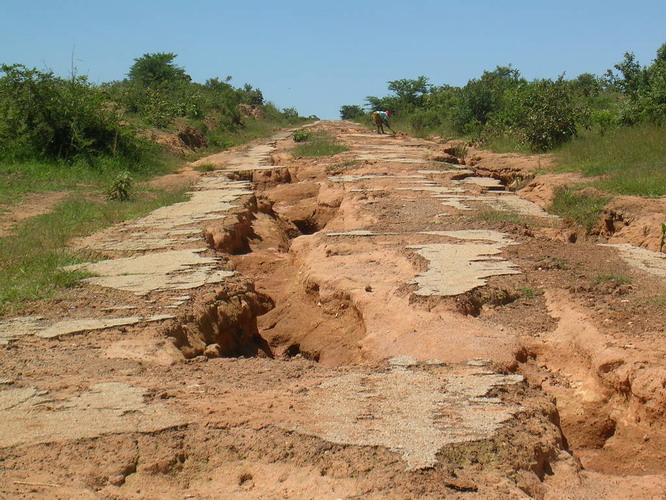 |
EU warning |
After Caconda, the road improved slightly except in the valleys which are often mud/water filled. At sunset we turned off the road (S14º21.362 E14º15.108), at what we thought was a quiet spot only for several people (and a motorbike) to walk by. We said hello and then gradually most of the village came by to have a look at us. The head man even came and seemed to be saying that we could stay in the village. We declined and thanked him, trying to demonstrate that the car was our home and that we were happy to sleep in our tent. Nice offer though, confirming that folk here are very friendly indeed.
Day 161: Monday 21 February
We were woken before dawn by a cheery call from the head man off out for the day. Various folk again stopped by including a woman trying to sell us eggs. Unfortunately, as they would have been very welcome, we had no way of cooking them and not enough Portugese to find out whether they had been boiled or not - though they looked like they were fresh from the chicken, as it happens! After attempting to dry off the tent (it had rained during the night so the tent was wet inside and out), we packed up and hit the road.
During this sort of travelling we loose track of days and sometimes need to check which day of the week it is. On the whole it is a good feeling though it can also feel strange. We have found that the only real reason to know is for something practical like whether the bank is open or not once you get to a city.
The road deteriorates again after Cacula. In fact an alternative road as been 'built' that almost feels like a by-pass if it weren't for the fact that the old road is bombed out or washed away so there is no alternative. We spotted a man filling in potholes with a hoe, an admirable if rather Herculean task. Later we were to see many other people doing the same thing. Some people seem to be doing it out of civic duty and a wish to see things (back to) 'normal' and working again. For others it was (also) a money making exercise with some folk putting up barriers or standing in the middle of the road when they heard / saw you approaching and asked for money.
For the last 20km or so into Lubango the road was graded. Heavenly! In Lubango we managed to change money at a Bureau de Change and buy petrol, cheap at 34K per litre and oil expensive. The KSV2 crowd had apparently been robbed in Lubango but we had no problems. It all seemed relatively civilised and reasonably well developed though there were alot of kids on the streets begging and searching through rubbish.
The 44 kms to Chibia were on alright tarmac after that the road deteriorated again. At dusk we turned off the road (at Sº15 51.959 E14º 07.241) and stayed at what turned out to be Chez Ant. Some of them bite too!
Day 162: Tuesday 22 February
It was a beautiful sunny morning except that we packed up pronto due to having to hop around trying to avoid being bitten by ants. We must have disturbed them last night, as you would do driving over someone's house! Getting under the landy to check suspension bolts was therefore quite a dangerous experience!
The road was relatively good in short sections followed by longer bad sections. In one of the bad sections we spotted a lad on his knees filling in potholes. As we got closer we realised he was not on his knees by choice but due to polio. We stopped and gave him some money. It seemed like he had been expecting more as he was disapointed with the 10K we had given him. It always seems so difficult to get these things right.
The vegetation and landscape were changing as we drove south, with now plenty of bayobab trees in evidence and watermelons and millet being grown. It looked as though much of the time this would be a very dry area, however we saw and experienced much flodding.
The road was mostly bad until Ondjiva. In Ondjiva we tried to fill up. There was diesel, but no petrol to be had except on the black market at 100K/litre or three times the usual price, so we said no thanks and went on our way. The last stretch of road to the border was beautiful tarmac (we never imagined describing tarmac in this way!) and a sign of things to come.
The border crossing was a hurried affair so that we could try to get into Namibia (Nam as they call it here!) that afternoon, before they closed the border for the day. This was more of a rush than we had expected as we had not realised/remembered that Namibia is one hour ahead of Angola i.e. fitting in with South African time. After the usual checking of documentation and stamping of documentation we were let through to the Namibian side. It was soon discovered however, that we had infact been given an entry stamp out of Angola and had therefore not officially left Angola. This meant that we were sent running back to Angola to get an exit stamp. Having obtained this we rushed back to the Namibian side to get ourselves stamped in before they all went home (at 5/6 pm). And what a different world we had just entered: time change, driving on the left, smooth tarmac, modern shops and ATMs.
Now in Namibia, so go back to the map and forward to Namibia. Bye for now.


